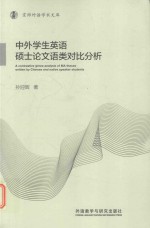

中外学生英语硕士论文语类对比分析PDF电子书下载
- 电子书积分:10 积分如何计算积分?
- 作 者:孙迎晖著
- 出 版 社:北京:外语教学与研究出版社
- 出版年份:2018
- ISBN:9787513596374
- 页数:231 页
Chapter One Introduction 1
1.1 Background 2
1.2 Research Objectives 5
1.3 Significance of the Research 6
1.4 Organization of the Book 7
Chapter Two Literature Review 9
2.1 Survey of Contrastive Rhetoric 9
2.1.1 Early Phases of Contrastive Rhetoric 10
2.1.1.1 ContrastiveStudies:ConcernonTransferofLinguisticPatterns 11
2.1.1.2 Contrastive Studies:Concern on Transfer of Logical Patterns 12
2.1.2 New Directions of Contrastive Rhetoric 14
2.1.2.1 Contrastive Text Linguistics Studies 16
2.1.2.2 Genre-Specific Contrastive Rhetoric 17
2.2 Survey of Genre Theory 17
2.2.1 Evolution of Genre 18
2.2.2 Three Linguistic Approaches to Genre Analysis 19
2.2.2.1 NR Approach 19
2.2.2.2 SFL Approach 20
2.2.2.3 ESP Approach 28
2.3 Genre-specific Studies in Research Papers 33
2.3.1 Introduction as a Genre 34
2.3.2 LRas a Genre 35
2.3.3 RD as a Genre 40
2.3.4 Results as a Genre 42
2.3.5 Discussion as a Genre 48
2.3.6 Linguistic Features 51
2.4 Summary 58
Chapter Three Theoretical Framework and Research Design 60
3.1 The Theoretical Framework 60
3.2 Research Methodology 63
3.2.1 Procedure 63
3.2.2 Corpora 64
3.2.3 Identification of Moves and Steps 67
3.2.4 An example of Move Analysis 68
Chapter Four Generic Structure Analysis 74
4.1 Generic Structure of Introduction 74
4.1.1 Move Structure of Introduction 74
4.1.2 Constituent Steps 76
4.2 Generic Structure of Literature Review 80
4.2.1 Move Structure of Literature Review 80
4.2.2 Move Cycles 83
4.2.3 Constituent Steps 85
4.2.3.1 Steps in Move 1:Making Introductory Statements 87
4.2.3.2 Steps in Move 2:Establishing Research Territory 89
4.2.3.3 Steps in Move 3:Evaluating Previous Research 94
4.2.3.4 Steps in Move 4:Announcing One’s Own Research 97
4.2.4 Summary 100
4.3 Generic Structure of Research Design 100
4.3.1 Move Structure of Research Design 101
4.3.2 Move Cycles 103
4.3.3 Constituent Steps 106
4.3.3.1 The Step in Move 1:Making Introductory Statements 108
4.3.3.2 Steps in Move 2:Introducing the Research Method 109
4.3.3.3 Steps in Move 3:Describing Experimental Procedure and Materials 111
4.3.3.4 Steps in Move 4:Describing Data Collection Instruments 113
4.3.3.5 Steps in Move 5:Describing Data Collection Procedure 115
4.3.3.6 Steps in Move 6:Describing Data Collection Methods 117
4.3.3.7 Steps in Move 7:Describing Data Analysis Methods 121
4.3.3.8 The Step in Move 8:Summarizing the Whole Chapter 124
4.3.4 Summary 124
4.4 Generic Structure of Results 125
4.4.1 Length of Results Section 125
4.4.2 Headings for Results Section 126
4.4.3 Organizational Pattern for Presenting Results 128
4.4.4 Generic Moves and Constituent Steps 129
4.4.5 Frequency of Moves and Steps 133
4.4.6 MoveCycles 136
4.4.7 Summary 137
4.5 Generic Structure of Discussion 138
4.5.1 Moves and Steps Identified and Frequency 138
4.5.2 Generic Structure of CSEs’Discussion 146
4.5.3 Generic Structure of NSs’Discussion 148
4.5.4 Move Cycles and Move Cycle Patterns 149
4.5.4.1 Frequency of Move Cycles 151
4.5.4.2 Move Cycles in CSEs’Discussion 152
4.5.4.3 Move Cycles in NSs’Discussion 154
4.5.5 Summary 156
Chapter Five Linguistic Features Analysis 158
5.1 Lexical Signals:Taking Introduction as an Example 158
5.2 Vocabulary Capacity:Taking RD as an Example 161
5.3 Citation Features:Taking LR,Discussion,and RD as Examples 164
5.3.1 Citations in LR 165
5.3.1.1 Basic Facts of Citations 165
5.3.1.2 Citation Forms 166
5.3.2 Citations in Discussion 169
5.3.3 Citations in RD 170
5.4 Reporting Verbs:Taking LR and Discussion as Examples 173
5.4.1 Reporting Verbs in LR 173
5.4.2 Reporting Verbs in Discussion 175
5.5 Tenses of Reporting Verbs:Taking Discussion as an Example 176
5.6 Hedging Devices:Taking Discussion as an Example 177
5.6.1 The Overall Frequency of Hedges 177
5.6.2 Description of Hedges Identified 179
5.6.2.1 Modal Auxiliaries as Hedges 179
5.6.2.2 Full Verbs as Hedges 181
5.6.2.3 Adverbs as Hedges 183
5.6.2.4 Adjectives as Hedges 185
5.6.2.5 Nouns as Hedges 188
5.7 First Person Pronouns:Taking Introduction and Results as Examples 189
5.8 Summary 191
Chapter Six Discussion 194
6.1 Similarities and Differences of Generic Features 194
6.1.1 The Overall Move Structure of the MA thesis 194
6.1.2 Moves and Move Cycles 196
6.1.3 The choice of steps 200
6.1.4 Linguistic Features 204
6.2 Possible Reasons for the Differences 207
6.2.1 Institutional Influence 208
6.2.2 Directness and Indirectness 208
6.2.3 Individualism versus Collectivism 211
6.2.4 First Language Tradition 211
6.2.5 Language Proficiency 212
Chapter Seven Conclusions 214
7.1 Summary of the Study 214
7.2 Pedagogical Implications 215
7.3 Limitations and Suggestions for Further Research 217
References 219
- 《水面舰艇编队作战运筹分析》谭安胜著 2009
- 《现代水泥技术发展与应用论文集》天津水泥工业设计研究院有限公司编 2019
- 《分析化学》陈怀侠主编 2019
- 《魏晋南北朝隋唐文学研究论稿》雷恩海主编 2018
- 《影响葡萄和葡萄酒中酚类特征的因素分析》朱磊 2019
- 《仪器分析技术 第2版》曹国庆 2018
- 《绿色过程工程与清洁生产技术 张懿院士论文集精选 上》《绿色过程工程与清洁生产技术》编写组编 2019
- 《全国普通高等中医药院校药学类专业十三五规划教材 第二轮规划教材 分析化学实验 第2版》池玉梅 2018
- 《Power BI数据清洗与可视化交互式分析》陈剑 2020
- 《行测资料分析》李永新主编 2019
